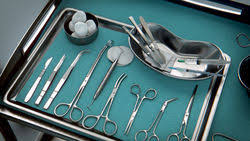5 Categories Of Equipment Used In General Surgery
This page reveals the 5 major categories of medical instruments used in general surgery.
As with every medical procedure, surgical instruments vary widely by field of study that they are used in.
Some equipment are reusable (most instruments fall into this category) while other equipment are single-use only.
There are a wide array of instruments available for use during a surgical procedure, each with their specific uses, advantages and disadvantages.
As a surgeon, nurse, student etc, it is important to know not only their names but when they should be used, and the category they fall under.
In this article, we cover the main categories of instruments used in general surgery.
Also Read: Best Ultrasound Machines To Buy And Their Prices
5 Categories Of Medical Instruments Used In General Surgery
Generally, instruments can be divided into 5 categories according to their functions.
1. Cutting and dissecting instrument
These instruments usually have sharp edges or tips to cut through skin, tissue and suture material. Surgeons need to cut and dissect tissue to explore irregular growths and to remove dangerous or damaged tissue. These instruments have single or double razor-sharp edges or blades.
Examples include:
Scalpels, scissors and saws, which are the most traditional use.
Other examples include Elevators which can be both for cutting and lifting/retracting. Although diathermy/cautery are often used as more modern alternatives.
2. Grasping or holding instruments
Grasping and holding instruments are used to hold tissue, drapes or sponges.
Examples include:
Forceps and clamps. Forceps can be divided into two which are traumatic forceps (tissue crushing) and atraumatic forceps (tissue preserving, such as Debakey’s)
3. Hemostatic instruments
Locking hemostatic forceps may be called clamps and are used to securely hold tissue. When they are used to control blood flow, they are called hemostats.
Hemostats are typically used to compress blood vessels or other tubular structures to obstruct the flow of blood or fluids.
This includes instruments utilized for the cessation of bleeding.
Examples are:
- Rankin forceps.
- Kelly forceps.
- Satinsky clamps.
- Kocher forceps.
- Crile forceps.
- Halsted Mosquito forceps.
- Mixter “right angle” forceps.
- Spencer Wells artery forceps.
4. Retractors
Surgery is often considered to be about exposure. A multitude of retractors exist to aid in exposing the bodies cavities accessed during surgery.
The two basic types of retractors are the hand-held and the self-retaining forms.
The hand-held retractors allow an assistant to move tissue out of the way of the surgical instruments and protect the vital structures during the procedure.
Examples of hand-held retractors are:
- Deaver’s Retractors
- Langenbeck’s Retractors
- Kelly Retractors
- Senn-Miller Retractors.
Self-retaining retractors remain open unless closed. These have screws, ratchets or clamps which holds the retractor open. Self-retaining retractors allow hands-free operation during a procedure.
Examples include:
- Weitlaner Retractors
- Gelpie Retractors
5. Tissue unifying instruments and materials
This is another category of surgical instruments that include tissue unifying instruments and materials such as needle holders, surgical needles, staplers, clips, adhesive tapes.
In Conclusion
Have you been searching online for categories of surgical instruments?
I hope you find this information helpful. If you do, please do not hesitate to share it now with your friends on social networks.

